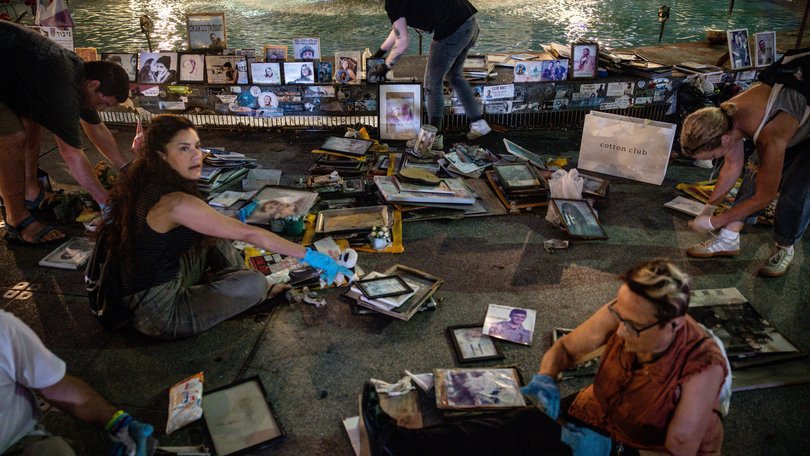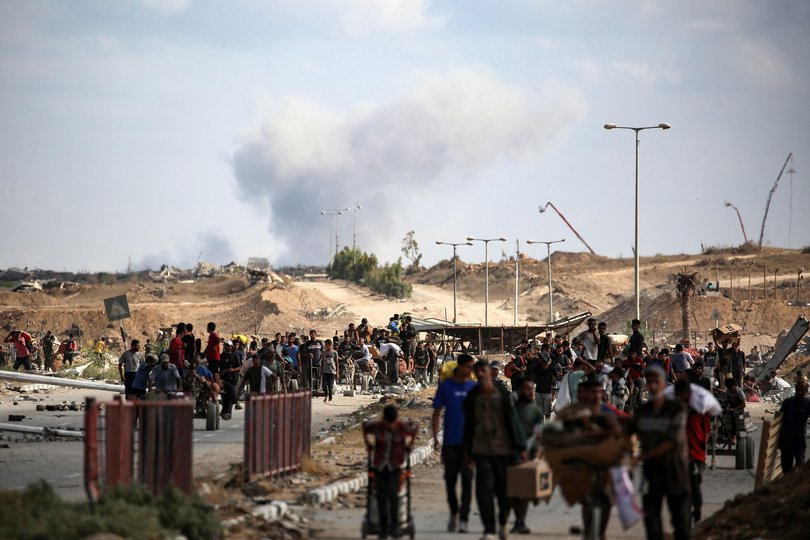Israel and Hamas prepare for negotiations in Egypt ahead of possible Gaza ceasefire

Israel and Hamas are preparing for indirect negotiations in Egypt on Monday, as hopes for a possible ceasefire in Gaza grew after Prime Minister Benjamin Netanyahu said a hostage release could be announced this week.
With Tuesday marking two years since the Hamas attack that sparked the war, US Secretary of State Marco Rubio said the US was hoping for a quick deal to bring home all hostages.
President Donald Trump has welcomed the Hamas statement accepting some elements of the US peace plan. Israel has said it supported the new US effort.
Sign up to The Nightly's newsletters.
Get the first look at the digital newspaper, curated daily stories and breaking headlines delivered to your inbox.
By continuing you agree to our Terms and Privacy Policy.Under the plan, Hamas would release the remaining 48 hostages — about 20 believed to be alive — within three days. It would give up power and disarm.
The delegation led by top Israeli negotiator Ron Dermer will leave Monday for the talks in Sharm el-Sheikh, Netanyahu’s office said. An Egyptian official said the Hamas delegation - led by senior leader Khalil al-Hayya - had arrived in Egypt. The official, speaking on condition of anonymity because he wasn’t authorized to brief reporters, said US envoy Steve Witkoff is joining the talks.
Discussions will focus on the proposed exchange of hostages for Palestinian prisoners held by Israel, Egypt’s foreign ministry said, but there is also expected to be a focus on the Israeli pullback on certain areas in Gaza.
However, Mr Rubio acknowledged there were formidable obstacles in the talks that would be addressed later.
However, he still described the situation as “the closest we’ve come to getting all of the hostages released.”
Speaking on ABC’s This Week,’ he described two phases after Hamas accepts Mr Trump’s framework: The hostages are released and Israel pulls back in Gaza to the “yellow line,” where it was in August.
Mr Rubio told CBS that Hamas should release hostages as they are ready, and that bombardment needs to end so they can be released.
The Hamas hostage release is still surrounded by uncertainty, given the prisoners still remain the terror group’s main source of leverage with Israel.
The US plan also addresses Gaza’s future. In a text exchange with CNN’s Jake Tapper, Mr Trump said there would be “complete obliteration” if Hamas stayed in power there despite the group’s continuing reservations about some of the terms of the US President’s proposal.
Mr Trump also texted that Mr Netanyahu was on board for ending the bombing and peace in Gaza but added, “soon on the rest.”
Mr Trump later conceded that, if necessary, “there will always be some changes to the plan”.
Support for a ceasefire grows
Israeli government spokeswoman Shosh Badrosian told journalists that Mr Netanyahu is in “regular contact” with Mr Trump and that the prime minister has stressed that the talks in Egypt “will be confined to a few days maximum.”
“I hope that we are closest to a hostage deal since the (ceasefire) deal in January,” Israeli Foreign Minister Gideon Sa’ar said in a speech.
Anxious relatives of hostages gathered near Mr Netanyahu’s residence in Jerusalem, with some urging Mr Trump to continue to apply pressure. Israel’s recent military offensive in Gaza City led many to fear for the hostages’ lives.
“We cannot allow such a historic agreement to be sacrificed again,” said Michel Ilouz, father of Guy Ilouz.
As hundreds of thousands of people marched across several European cities and elsewhere in support of Palestinians, the foreign ministers of eight Muslim-majority countries issued a joint statement welcoming steps toward a possible ceasefire.

They also underlined their commitment to the return of the Palestinian Authority to Gaza, unifying Gaza and the West Bank and reaching an agreement leading to a “full Israeli withdrawal” from Gaza.
Mr Rubio told ABC that decisions regarding a governing structure or international group to manage Gaza can take place simultaneously with the ceasefire’s first step.
“That’s the part that I think is going to be a little tougher to work through, but that’s what’s going to provide permanency to the end of the conflict,” he said.
Indeed, officials from Hamas have also expressed reluctance about both the presence of an international security force and surrendering their weapons.
Other perceived sticking points are believed to be the complicated nature of the repatriation of Israeli hostages - both living and dead - from the militant group’s tunnels under Gaza City.
There are also expected to be disagreements between Israel and Hamas over the Palestinian prisoners to be freed under the plan, given the fact many have been jailed for attacks on Jewish civilians.
Then there is also the issue of how far Iraeli forces will commit to withdrawing from the parts of Gaza that they currently hold.
At least 12 killed in Gaza on Sunday
Mr Trump has ordered Israel to stop bombing Gaza, but residents and local hospitals said strikes continued across the territory.
The Israeli government spokeswoman, Ms Badrosian, said “certain bombings have actually stopped inside of the Gaza Strip.”
But Israel’s military chief of staff, Lt. Gen. Eyal Zamir, said that “if the political effort does not succeed, we will return to fight.”
At least eight people were killed Sunday in multiple strikes in Gaza City, according to Shifa Hospital, which received the casualties. A security official who spoke on condition of anonymity because they were not authorized to talk to the media said the strikes were against Hamas militants who were a threat to troops.
Four other people were shot dead near an aid distribution site in the southern city of Rafah, according to Nasser Hospital. Israel’s military said it was not involved.
Doctors Without Borders confirmed the death of colleague Abed El Hameed Qaradaya, who was wounded in an attack Thursday that killed another colleague in Gaza.
Gaza’s Health Ministry said the Palestinian death toll in the war reached 67,139 on Sunday, with nearly 170,000 injured. The ministry does not differentiate how many of those killed were civilians or combatants, but says women and children make up about half of the dead.
The ministry is part of the Hamas-run government, and the UN and many independent experts consider its figures to be the most reliable estimate of wartime casualties.
Israel’s military has said it continues to dismantle Hamas infrastructure and warned residents not to return to northern Gaza.
“We’re on the brink, and we don’t know whether one will die of a strike or starvation,” said Mahmoud Hashem, a Palestinian father sheltering in a tent in Gaza City.
